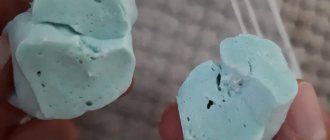Is it possible to drink defrosted
Is it acceptable to drink frozen vodka? This is a question on which experts have two points of view:
- Can. Regardless of the final state after a little defrosting, most people accept the possibility of drinking frozen vodka. The reason is that previously vodka was frozen on purpose. This process was called “freezing out” and operated on the principle “everything unnecessary is frozen and is ice, and the rest is pure vodka that needs to be drunk.” This is partly true, since alcohol completely freezes only at a temperature of -117°C, and everything else - water, additives - at a temperature of -20°C.
- It is forbidden. The second point of view categorically denies the possibility of drinking frozen vodka for two main reasons: technology and temperature. Let's look at it in order. If the vodka and bottle were completely frozen, this indicates non-compliance with the production technology. The use of such a product is dangerous to health due to non-compliance with GOST standards and violation of the proportions in the composition of the drink.
Temperature affects the fact that cold vodka is not noticeable when consumed. A person ceases to smell and taste it, and the receptors are dulled due to the low temperature of the drink itself. The result is “sudden” intoxication and severe intoxication of the body in the shortest possible time.
Packaging, labeling and storage of ethyl alcohol
Rectified ethyl alcohol is poured into specially equipped tanks or containers, barrels, bottles, canisters, which are closed with lids or stoppers that ensure tightness, sealed or sealed. Bottles are packaged in special boxes or baskets. The use of galvanized steel containers is prohibited.
The following markings are applied to the transport container: name of the manufacturer, its address; name of alcohol; volume, gave; gross weight in kg; barrel, bottle, canister and batch number; the inscription “Flammable liquid”; danger sign; classification code 3212, UN number-1170; designation of the standard.
Ethyl drinking alcohol 95% is poured into glass bottles with a capacity of 1.0, 0.5 and 0.25 dm3, which are sealed with a cork stopper with a parchment paper lining or a polyethylene stopper, and then with an aluminum cap, on which the manufacturer’s stamp and volume are applied. proportion of alcohol.
A label indicating the name of the product is placed on the bottle; brand; name and location (addresses) of the manufacturer, packer, exporter, importer; name of the country and place of origin of the goods; manufacturer's trademark (if available); strength (volume fraction of ethyl alcohol); volume, l; bottling date (on the back or front side of the label, on
caps or back labels or directly on consumer packaging in places that are easy to read); designations of regulatory or technical documentation in accordance with which the product is manufactured and can be identified; certification information.
Bottles of alcohol are placed in wooden boxes, on which the following information is applied with indelible paint: name of the manufacturer; name of alcohol; number and capacity of bottles; gross weight; bottling date, standard designation; "Flammable", "Top" and "Caution - Glass" signs
Rectified ethyl alcohol in tanks and reservoirs is stored outside the production premises, and in barrels, bottles and canisters - in an alcohol storage facility
Bottles and canisters are placed in one row, and barrels - no more than two in width and height in each stack. Ethyl alcohol is a volatile, flammable liquid, and according to the degree of impact on the human body, it belongs to the 4th hazard class. The maximum permissible concentration of alcohol vapor in indoor air should not exceed 1000 mg/m3. To avoid explosion, tanks, equipment related to the technology, storage and movement of ethyl alcohol must be protected from static electricity.
Rectified ethyl alcohol in tanks and reservoirs is stored outside production premises, and in barrels, bottles and canisters - in an alcohol storage facility. Bottles and canisters are placed in one row, and barrels - no more than two in width and height in each stack. Ethyl alcohol is a volatile, flammable liquid, and according to the degree of impact on the human body, it belongs to the 4th hazard class. The maximum permissible concentration of alcohol vapor in indoor air should not exceed 1000 mg/m3. To avoid explosion, tanks, equipment related to the technology, storage and movement of ethyl alcohol must be protected from static electricity.
The shelf life of alcohol is unlimited.
↑ Roskachestvo revealed the secrets of choosing good champagne
On the eve of the New Year, Deputy Head of Roskachestvo Ilya Loevsky revealed to Rossiyskaya Gazeta the secrets of choosing the most important New Year's drink - champagne.
The dance of 69-year-old Pugacheva in mini-shorts was leaked to the Network (VIDEO)
First, you need to read the label carefully, since stores sell not only natural sparkling wine, but also “sparkling wine drinks” with elegant names in a foreign style.
“This drink can smell like strawberries, peach, other fruits and berries. Its composition, as a rule, includes wine material (up to 50 percent), water, flavorings, dyes and artificial carbonation,” says Loevsky.
As a rule, the price of such “champagne” is up to 150 rubles. And the price of natural sparkling wine starts from 300 rubles (if it is not on sale).
The label must say “sparkling wine” or “carbonated wine drink.”
Also, if the champagne is domestic, the packaging may be marked “wine of protected geographical indication” or “wine of protected appellation of origin.”
Secondly, price matters. Especially if you are choosing between Russian and foreign champagne.
Is it possible to store vodka in the freezer? At what temperature does a drink freeze?
You urgently need to cool the bottle, but you don’t know whether vodka freezes in the freezer and whether it can be drunk after that? Alcohol cooled in this quick way will not spoil at all after proper defrosting. This is also how the drink is checked for quality.
At what degrees does vodka freeze?
The freezing point of vodka depends on the alcohol content in it. The more alcohol in vodka, the lower the temperature for it to solidify. A 40% aqueous solution of ethyl alcohol will freeze at 23-29 degrees below zero. For a 30% drink the mark will rise to -17-20 degrees, for a 55% drink it will drop to 39-42 with a minus sign.
In a standard refrigerator freezer, the temperature ranges from –5 to –20 degrees. To test vodka for quality, set the temperature in the range of –22–27, if technology allows.
After some time, the vodka thickens, then becomes covered with an ice crust. For an alcoholic drink to freeze, a temperature of no higher than -27 degrees is required, or better yet, lower. Not every technique has this function.
Freezing and quality
Vodka is frozen not so much for long-term storage, but to check its quality. If the drink has completely turned into ice, this indicates a high percentage of sugars and other additives.
If the bottle was in a powerful freezer at a temperature below the required temperature, then its contents can be thawed and drunk - this vodka is good. The drink will not lose its properties after returning to room temperature.
If vodka hardens at temperatures above –22°, then its quality can be doubted. It's even worse if the drink changes color.
Check the product by freezing to protect yourself from poisoning. There are reviews that even high-quality Beluga freezes at standard freezer settings.
Drinking culture
The freezer is great for quickly chilling a bottle of vodka. The optimal temperature for drinking an alcoholic drink is +8 degrees Celsius. If the time for the feast has not yet come, it is better to put vodka in the refrigerator.
How to store vodka? A refrigerator, and especially a freezer, is not needed for this; a dark place—a closed closet—will do. An open bottle is tightly sealed and not stored for a long time; the optimal place is away from foreign odors.
Any vodka will freeze if left in the cold for a long time. The main indicator is the rate of hardening and temperature in the chamber. In this way, you can distinguish counterfeits based on methyl (technical) alcohol that are dangerous to health.
Climate of the Black Sea coast
Most of the territories washed by the Black Sea have a continental climate. This means that the weather here is dry and warm in summer and damp, cool in winter. The average winter temperature on the northern coast is -2 °C. Basically, this is the coast of the Caucasus and Crimea. Those areas that are not covered by mountains are exposed to northern winds, where the temperature can drop to -30 °C.
But the Atlantic Ocean has a great influence on the climate of the Black Sea coast. It brings cyclones, which cause severe winter storms. They usually come several at a time, so bad weather on the coast often lasts all winter.
Does beer freeze
Beer also contains an ethyl alcohol product. At what degrees will it freeze? The freezing point of this drink ranges from -2 to -3 degrees. That is, in the freezer the beer will harden very quickly and easily. At the beginning of the crystallization process, water first solidifies in beer and gradually turns into ice. Beer becomes like a drink with pulp. After a certain time, ethyl alcohol also solidifies, it all depends on its concentration in the beer. That is, the beer does not freeze all at once, it happens gradually.
Many people argue whether it is possible to drink beer that has frozen and thawed again. There is no answer to this question, since all people have different tastes. In many countries, beer lovers prefer to drink frozen beer. And someone has warm beer. However, drinking slightly chilled beer is still considered optimal.
There is an opinion that beer that is frozen and then thawed loses its taste, becomes cloudy and has an unpleasant odor. This is not 96 degree alcohol, which will not lose its taste. Fermentation processes stop. Beer is not what it should be. It is up to everyone to decide whether to drink or not to drink such a drink. All low-alcohol drinks, such as wine, cocktails, vermouth, and so on, are frozen using the same principle.
You should not experiment and freeze alcohol. It is enough to slightly cool the drink and drink it in pleasant company. The most important thing is not to abuse it, as alcohol can ruin not only your mood, but also your health for life.
A little chemistry
Raoult's second law deals with the percentage of alcohol in liquids, which changes the crystallization temperature. According to this law, the decrease in temperature at which a liquid crystallizes depends only on the number of moles in the concentration of that liquid. There are special formulas that allow you to calculate the freezing point of alcohol based on its strength.
Some experts in this field say that this law cannot be used to calculate the freezing point of alcoholic beverages. Since its influence extends only to compounds that are not volatile. But practical experience suggests the opposite. All processes occurring in practice confirm the calculations made using formulas.
Can vodka freeze in the freezer or refrigerator?
If vodka is frozen in the freezer at home, this means that you purchased low-quality products. Freezing in such a situation indicates a high concentration of additional impurities in the composition or a low alcohol content. Since production standards are regulated at the state level, such a drink may be counterfeit, so its use is fraught with negative consequences.
Vodka is usually served chilled, as this improves its taste. The optimal temperature for serving is +8 °C.
Although, some fans like vodka straight from the freezer. This drink looks quite interesting. In appearance it resembles a thick, viscous jelly, and when consumed there is practically no bitter taste or specific smell.
People often talk about the temperature at which 40 degrees vodka freezes during celebrations and feasts. This topic is raised out of curiosity, but the question is quite important. Based on the freezing temperature, you can judge the quality of the product. By freezing vodka, you perform a kind of testing that will help avoid poisoning.
Vodka is an alcoholic mixture in which water acts as a solvent and ethanol as a soluble substance. When creating such mixtures, particular importance is given to the uniform mixing of the ingredient molecules and the degree of their interaction. Let's look at how many degrees vodka freezes at
This is affected by the concentration of ethyl alcohol, the freezing point of which is minus one hundred and seventeen degrees Celsius. Many people remember from a school chemistry course that the freezing point of water is close to zero. Based on this, we can say that the freezing point of vodka depends on the amount of water and ethyl in the mixture. The higher the concentration of water, the lower the temperature required for the liquid to freeze.
Let's look at how many degrees vodka freezes. This is affected by the concentration of ethyl alcohol, the freezing point of which is minus one hundred and seventeen degrees Celsius. Many people remember from a school chemistry course that the freezing point of water is close to zero. Based on this, we can say that the freezing point of vodka depends on the amount of water and ethyl in the mixture. The higher the concentration of water, the lower the temperature required for the liquid to freeze.
Features of serving various wines
Natural sweet, dessert and semi-sweet wines
The range of such wines is very extensive. Natural Sweet Wines include Rivesaltes, Mori, Banyuls, Rasteau and various Muscats. The Charente vineyard also produces an excellent dessert wine: Pinot de Charente. Among the semi-sweet wines one can name, among others, Jurançon, Montbazillac, Sainte-Croix-du-Mont and, of course, the prestigious Sauternes and Barsac.
Dry white wines
These are also excellent aperitifs, characterized by originality and individuality. They can be served separately or in combination with blackcurrant liqueur (Kir), raspberry, strawberry liqueurs, etc.
Each white wine has its own special aroma: linden (Loire Valley), fruit (Bordeaux), flowers (Alsace), vermouth (Languedoc), almond or hazelnut (Burgundy and Macon). . White wines should be served very chilled.
Red wines
When they are light, young and fruity (new and early wines), some red wines are also very pleasant as an aperitif. Among such wines are “Beaujolais”, “Cotes du Rhone Example”, “Bourgueil”, “Chinon”, etc.
You can also flavor some of these wines by adding fruit liqueur (Beaujolais with blackcurrant liqueur).
For an aperitif, red wines should be served chilled.
About the rules of wine tasting...
Champagne and sparkling wines
Champagne and vintage sparkling wines (Saumur, Blanquette de Limoux, Crémant de Bourgogne, de Loire, d'Alsace, etc.) go well with fruit liqueurs (raspberry, blackcurrant, etc.). Of course, served alone, they make an excellent aperitif.
Champagne and all sparkling wines should be served very chilled.
Properties of water and its freezing point
A water-alcohol solution, like any other, has different physical and chemical properties: vodka has its own freezing point, the ability to react with certain substances, but many people are only interested in the effect of this drink on the human body.
It has long been noted that alcohol in small doses (about 20-25 g of alcohol) relaxes, gives pleasant lightness and ease in communication. However, with increasing dosage, negative consequences such as loss of coordination, decreased attention, and lack of an adequate assessment of reality and one’s own behavior begin to rapidly increase.
Few people know that they tried to use vodka and alcohol as anesthesia (in the absence of other drugs), but this method had to be abandoned. Too thin a line lies between loss of sensitivity and unconsciousness (as needed for surgery), as well as death.
Alcohol is a chemical compound consisting of two carbon atoms, one oxygen atom and six hydrogen atoms. Chemically, its formula is described as C2H5(OH). It is a colorless liquid and few people have seen it frozen. But, as you know, all substances can be transferred from one state of aggregation to another, it’s all just a matter of temperature.
Mercury, which is common in medical thermometers, is a metal, but under normal conditions we know it as a liquid. When cooled to 38 degrees below zero Celsius, it will turn into a solid phase. Consequently, when cooled, alcohol will sooner or later become crystalline. Why can't we see frozen alcohol? The thing is that it needs to be cooled very much.
Under terrestrial conditions, alcohol freezes at a temperature of minus 115 degrees Celsius. Such a temperature has simply never been recorded on our planet and is only available in laboratory conditions. This quality is due to the fact that many antifreeze or cleaning fluids contain it in their composition so that they can successfully perform their functions in winter. We also established that alcohol in the freezer will not freeze under any circumstances.
It should also be noted that this liquid is flammable, boils at seventy-eight degrees; in Brazil, for example, alcohol is used instead of gasoline in internal combustion engines of cars.
Water is a chemical compound of two hydrogen atoms and one oxygen atom. Its chemical formula is H2O.
Many call water the most amazing liquid in the Universe. First of all, it gives life to our planet and this is connected with one extraordinary property of water, which, besides it, only two substances have. As you know from school physics courses, any substance decreases in volume when cooled; water behaves similarly, but only up to a temperature of 4 degrees Celsius.
Water turns into ice at zero degrees Celsius, which is not at all surprising, since the freezing point of water was chosen as the beginning of the temperature scale. The boiling point of this liquid is 100 degrees and this is the second reference point of the Celsius temperature scale.
The main element of all high-proof drinks is ethyl alcohol. Ethanol is a transparent liquid, colorless, with a specific odor and pungent taste. Strict technology and proper conditions such as pressure and temperature are used in its production. Characterized by the ability to ignite and evaporate quickly.
Ethyl alcohol has found application in:
- chemical industry;
- medicine;
- production of cosmetic products and perfumes;
- the food industry, where it is used as the main component of alcohol-containing drinks: vodka, wine, beer and others.
Classification of ethanol by type:
- Medical - contains 96.4-96.7% alcohol.
- Ethyl absolute (pure) - 99.9%
- Rectified - 95.57% alcohol.
Some basic physical properties of alcohol:
- boiling point: 78.39 C (Celsius);
- pour point (melting point): - 114.5 C (Celsius);
- can be combined with: water, acetone, acetic acid, benzene, glycerin, diethyl ether, chloroform.
Is it possible to drink frozen vodka?
When vodka freezes, the question immediately arises as to whether it can be drunk. Theoretically, this is not prohibited, but there are several nuances.
Firstly, if the vodka is frozen at a low temperature, and there is already a lot of ice in it, then most likely it is diluted and not made according to technology. We do not recommend drinking this, although you can throw away the ice and drink the remaining liquid, which will already contain more alcohol. Previously, they used this method of purifying vodka - freezing, when excess water froze, and the remaining mixture became cleaner and better.
Secondly, frozen vodka should be drunk very carefully. Heavily chilled, viscous, it practically does not smell or taste, and the cold additionally dulls the receptors. Therefore, you can drink a lot of it, and then instantly become very drunk, which leads to severe toxic poisoning
Therefore, you can drink a lot of it, and then instantly become very drunk, which leads to severe toxic poisoning.
So if you are not against alcohol, then at least use it correctly, so that there are no unpleasant consequences.
From the history
Many people mistakenly believe that vodka was invented by D.I. Mendeleev. In fact, this product appeared much earlier, back in Persia. And Dmitry Ivanovich worked a lot and closely on the properties of solutions, including alcohol ones. His doctoral dissertation was called “On the combination of alcohol with water,” where he scientifically substantiated the ideal strength - 60 parts of pure water and forty parts of alcohol.
For the first time in our country, vodka appeared under Dmitry Donskoy, but neither the princes nor the common people were interested in the innovation. They thought that our honey ones were much tastier. In 1429, vodka was again brought to Rus', but as a medicine. Since then, it has taken root on our lands.
Ideal temperature
No matter how the taste of vodka improves from frost, it is recommended to drink it chilled, but not ice-cold. The ideal temperature for this drink is 5 - 10 degrees above zero. Doctors recommend this temperature because of the health hazards of ice-cold vodka. Alcohol business experts explain these figures by saying that this is when the true taste of this popular drink is revealed. The most purified and high-quality vodka has a sweetish taste. This is one of the characteristics of diluted ethyl alcohol.
If you like very chilled vodka, then you can make a compromise. Serve alcohol at moderate temperature. But use frozen shot glasses as utensils.
- The bitterness of vodka and its pungent aroma are caused by insufficient purification of alcohol. It is the impurities that affect these characteristics.
- Mendeleev is considered the inventor of vodka. However, his dissertation was related to solutions of alcohol in water. And the presented compound had 38% alcohol in its composition.
- Until the middle of the 17th century, the concepts of “moonshine” and “bread wine” were used. And under Elizabeth II the term “vodka” appeared.
- Annual global sales of vodka exceed 4 billion liters.
- During World War II, Soviet soldiers were given 100 grams of vodka every day. The liquid was supposed to give courage to the defender of the Motherland and reduce pain in case of injury.
- Cheap vodka is not purified from impurities. To reduce the harshness of the smell and taste, manufacturers use products that can soften the drink.
- Alcohol is the most common cause of death. But the leaders are not poisoning with a surrogate, but accidents and crimes that are committed against the background of alcohol intoxication.
- Traditional medicine for a bee sting suggests drinking vodka instead of taking antihistamines.
- Consuming a liter of vodka at once causes death. Half a liter causes cardiovascular disorders such as heart attack, cardiac arrest or stroke.
Vodka is a drink that no holiday in Russia can do without. But whatever its freezing point, it continues to be not only the main subject of the feast, but also a drink that causes medical and social consequences.
Deposits in the washer reservoir, hoses and washer nozzles
I already wrote above about the washer reservoir heating system. Those. throughout the winter, a “boiler” operates in the tank. It is clear that it is not 100 °C there, but deposits like in a home kettle are guaranteed. And the more, the less purified the water that was used to make the washer fluid. Therefore, the “left” liquid, which is sold on the side of the road, is harmful to the windshield washer systems of Mercedes. Plaque on the boiler reduces heat transfer to the liquid, i.e. it takes longer to heat up. And most importantly, deposits clog the windshield nozzles, and broken pieces of plaque damage the seals of the telescopic sections of the headlight washer nozzles. And the latter begin to flow. On some machines this is less noticeable. This is especially true on S-classes like W221.
At what temperature does vodka freeze?
The determining point at how many degrees vodka can freeze is the percentage of rectified water. If you place a bottle of alcoholic drink in the freezer, at the first stage the liquid thickens and becomes like liquid jelly. Then, when the temperature of the solution drops to -20ºС, thin plates of ice appear that can freeze together, forming an ice crust.
The freezing point of vodka at 40 degrees ranges from -27...-30ºС, that is, we can conclude that in the freezer of a household refrigerator, where the minus mark does not exceed -24ºС, a high-quality drink will not cool to a crystalline state. In winter, if there is a severe frost outside -30ºС, an experiment in freezing an aqueous-alcoholic liquid can be carried out by determining the temperature with an outdoor thermometer.
Various varieties of the popular alcoholic drink are produced (traditional Russian vodka, Finnish vodka, Korean rice vodka, Swedish Absolut or Pincer Shanghai Strength - the strongest vodka in the world), the strength of which varies from 32 to 88.8%. The freezing temperature of the water-alcohol mixture also changes in direct proportion.
Doctors do not recommend drinking chilled, thickened vodka - a low-temperature drink can provoke an exacerbation of tonsillitis, sore throat or inflammation of internal organs.
Another reason is that an ice-cold alcoholic drink loses its characteristic smell and taste, and the intoxicating effect becomes distant. Cold dulls the sensitivity of receptors, a person has less control over the situation and easily exceeds the permissible dose of alcohol.
Raoult's law
At the end of the 18th century, the French scientist Francois Raoult studied the decrease in crystallization temperature and decrease in vapor pressure (increase in boiling point) of solutions when changing the concentration of introduced substances, and derived several laws for the behavior of ideal solutions.
Raoult's second law states that the decrease in the boiling point and increase in the freezing point of a solution is directly proportional to its molal concentration.
The law applies to infinitely dilute solutions and is not affected by the nature of the introduced component.
Does this law apply to an aqueous-alcohol solution, and what will be the freezing point of vodka according to Raoult’s conclusions? All the laws of Francois Raoult apply to ideal solutions of non-volatile substances, and alcohol evaporates very actively and creates an increased vapor pressure above the surface of the water-alcohol mixture. So we can calculate with a small error: the freezing point of 40% vodka is -27 °C.
It’s worth saying right away that talking about freezing at this temperature is incorrect for some reasons. During crystallization, ice particles of water form, and in the remaining mixture the concentration of alcohol increases, and, consequently, the freezing point of the liquid mixture changes. So, from a scientific point of view, it is correct to talk not about the freezing temperature, but about the point at which the crystallization process begins.
Freezing point of alcohol
Alcohol is a chemical compound consisting of two carbon atoms, one oxygen atom and six hydrogen atoms. Chemically, its formula is described as C2H5(OH). It is a colorless liquid and few people have seen it frozen. But, as you know, all substances can be transferred from one state of aggregation to another, it’s all just a matter of temperature.
Mercury, which is common in medical thermometers, is a metal, but under normal conditions we know it as a liquid. When cooled to 38 degrees below zero Celsius, it will turn into a solid phase. Consequently, when cooled, alcohol will sooner or later become crystalline. Why can't we see frozen alcohol? The thing is that it needs to be cooled very much.
Under terrestrial conditions, alcohol freezes at a temperature of minus 115 degrees Celsius. Such a temperature has simply never been recorded on our planet and is only available in laboratory conditions. This quality is due to the fact that many antifreeze or cleaning fluids contain it in their composition so that they can successfully perform their functions in winter. We also established that alcohol in the freezer will not freeze under any circumstances.
It should also be noted that this liquid is flammable, boils at seventy-eight degrees; in Brazil, for example, alcohol is used instead of gasoline in internal combustion engines of cars.
How long is it legal to sell alcohol in Russia? How to drink and what to eat Georgian moonshine - chachaVodka with pepper for colds: how to take, recipe How to infuse moonshine on oak bark at home
How do different types of alcohol behave under the influence of negative temperatures?
There are several alcohol groups that have a specific classification. This classification is based on similar physical and chemical parameters belonging to the same group. The groups are broken down as follows:
Alcohol groups
- According to the size of hydroxyl groups - monoatomic and diatomic, as well as polyatomic substances;
- According to the nature of the behavior of the hydrocarbon substituent, its cyclicity - alicyclic, cyclic;
- According to the presence in the quantitative equivalent of substituents of the alpha carbon atom - primary, secondary, tertiary;
- According to the level of saturation of the hydrocarbon substituent - saturated, unsaturated, aromatic.
Based on the classification, it is possible to analyze some types of alcohol for their ability to crystallize and determine at what temperature the alcohol freezes. Methanol is a monohydric substance. The freezing point of alcohol is -97 degrees Celsius. Hexalin (or cyclohexalin) belongs to the group of acyclic substances. It is capable of crystallizing at -42 degrees. An aromatic alcohol of the benzyl group - phenylcarbenol turns into ice at -15 Celsius.
Related video: What can be done with alcohol
https://youtube.com/watch?v=yMKp_v5KU-E%3F
Alcohol solutions
The fact is that vodka is not pure alcohol, but is a solution of water in which a proportion of alcohol is present. Depending on what this proportion is, the freezing temperature changes.
The “scatter” of values at which vodka undergoes crystallization is from -27ºС to -34ºС. These are approximate figures. The more ethanol in vodka, the lower the limit will be when it can turn from liquid alcohol into, so to speak, “alcoholic ice cream.”
The following is interesting: the freezing process occurs gradually, the vodka thickens, turning into a kind of jelly, and only after that, if the temperature does not change, it becomes solid. And it almost never freezes entirely.
Reason: first the water particles change their characteristics - they become small pieces of ice. The alcohol concentration in the bottle becomes higher, so the solution now needs a lower temperature to become ice.
Alcohol-containing drinks are also resistant to cold, but it is still possible to freeze them - like wine from European cellars, which, by the fact of its freezing, clearly indicated the extreme temperatures for those latitudes and times. It's all about water and other additives that make a solution from pure alcohol, diluting its concentration.
A solution in which there is 2 times less alcohol than water freezes at -17°C. If the ratio of alcohol and water is 1:3, then its freezing point will already be -11 degrees below zero.
Vodka is a 40% alcohol solution, that is, it contains 6 parts water and 4 parts alcohol. It freezes at 25–29° below zero. If the drink turns into ice at a higher temperature, for example, -20 degrees, this is already a serious reason to doubt its quality and composition. Vodka, diluted half and half with water, becomes a solid state already at -7.5°C.
In this case, vodka freezes gradually, but not in the same way as water. At first it becomes viscous, jelly-like, and then turns frosty in separate plates. This is due to the fact that as the solution freezes, the concentration of ethanol increases, and the solidification process proceeds unevenly. Thickened vodka does not have a characteristic taste or smell, making it easy to drink, and therefore it is very easy to get carried away with the experiment, go too far with its quantity and get seriously poisoned.
Beer is a low-alcohol drink because it contains little ethanol. And it freezes already at -2 degrees, as everyone knows who has ever forgotten beer in the freezer, hoping to cool it faster. Drinking such a drink is not dangerous, but it may lose its taste. The same applies to all low and medium alcoholic drinks: wine, vermouth, cocktails.
Interestingly, strong cooling plays a significant role in the preparation of a number of alcoholic beverages. According to the technology, some varieties of brandy and metaxa are specially aged at -6°C for several months.
General definition of characteristics
In physics, the temperature index of freezing denotes the regime at which a certain substance being determined passes from a liquid state to a solidified (crystalline) form. All ultimately obtained figures demonstrating the level at which a certain compound changes its aggregate form (liquid-solid) are individual.
These indicators are directly affected by the following readings:
- What impurities and additional suspensions are in the liquid.
- Exactly what substance is being cooled (its composition and molecular properties).
- The level of atmospheric pressure present during cooling. That is, the higher the pressure level, the correspondingly higher the freezing temperature.
The absolute freezing point of ethyl alcohol (C2H5OH) is -117⁰C (in some sources it is indicated in the range from -114⁰C to -115⁰C). However, on the surface of our planet such a temperature regime is simply impossible. Therefore, all liquids that contain ethanol in one proportion or another cope well with low temperatures.
What is ethyl alcohol
Also, the production of some alcohol-containing drinks requires the presence of low temperatures. Let’s say that metaxa or many exclusive types of brandy according to the technological process are kept for several months in refrigerated cellars with ambient air readings of -6⁰C.
Vodka froze: reasons
So, we have already determined that the main reason for vodka freezing in the freezer is a low-quality composition: a minimum percentage of alcohol and a high water content. It is also worth taking into account additives that affect the ratio of ingredients. Vodka of poor quality composition causes “damage” not only to the taste, but also to the effects expected from it. However, not in all cases the alcohol producer is the culprit.
The problem with this is often associated with a refrigerator whose freezer compartment exceeds the permissible low temperature threshold. In all other cases, there should be no changes in the state of alcohol. In other words, if the freezer is working properly and its temperature value is standard, high-quality vodka will not freeze there.
We recommend reading:
Storing champagne in the freezer and what to do when it freezes
How long does beer last?
How long does boiled pasta last in the refrigerator?
How to defrost
We figured out how to freeze vodka. What conclusions can be drawn about a drink if vodka, after lying in the freezer for some time, turns into ice?
This may indicate either that there are too many impurities in the drink that lower the freezing temperature threshold, or that the freezer is set too low.
Despite many prejudices, good quality vodka with sufficient alcohol content does not change its properties at all after defrosting. The hot drink retains its smell and taste.
Frozen vodka must be defrosted properly.
You should not use any special devices for this purpose. Just put the bottle on the table and wait a little. As a last resort, you can warm the drink with warm water.
A microwave oven should not be used to defrost frozen vodka; this can damage the molecular structure of the alcohol and spoil the taste.
Checking vodka for quality
Knowing at what temperature alcohol crystallizes in different alcoholic drinks, you can check the compliance of the alcohol-containing container with the standards. The alcoholic drink must be placed in the freezer compartment of the refrigerator. A chilled drink will make it easier to drink. But an unpleasant situation may arise. Alcohol turned to ice at a temperature higher than permissible. It is recommended to avoid this drink, as it can cause poisoning. Premature crystallization of a liquid can be due to the following reasons:
- Low alcohol content.
- The presence of additives, flavorings, salts or preservatives.
- A low level of alcohol purification, as a result of which it contains various impurities or oils.
The temperature in the freezer compartment of any refrigerator does not fall below minus 25-28 degrees. If a drink placed in the freezer is frozen, it is better not to drink it. It may not be safe for your health.
There are several other ways to check quality at home. They are as follows:
- Sulfuric acid. You can ask any motorist for a few drops of it. You can take it with a pipette from the battery and mix it with vodka. This is how the concentration of fusel oils is determined. If the mixture turns black, it is better not to drink the drink.
- Arson. An alcoholic drink of 40% burns with a small flame of a bluish tint. If the vodka does not light, then it is of poor quality.
- Smell. To enhance the alcoholic effect of the drink, the manufacturer can add industrial alcohol or acetone to the drink. This alcohol produces a pungent odor and is not recommended for consumption.
General advice is to avoid consuming a product if there is any doubt about its contents.
Everyone needs to know
Vodka belongs to strong alcoholic drinks and is one of the most popular drinks. Around the world, about a billion liters of the drink are consumed every year. High-quality, good products undergo a distillation process, which inexpensive vodka does not undergo.
To enhance the taste characteristics, unscrupulous manufacturers add flavoring aromatic additives and various impurities to the prepared product.
Contrary to the general opinion, vodka was not invented by D.F. Mendeleev. The writing of the dissertation and subsequent works were associated with alcohol solutions, which did not exceed thirty degrees in strength. The concept of “vodka” appeared in the mid-18th century and replaced the concepts of “bread wine” and “moonshine”.
- Alcohol is very often the cause of death.
- Drinking 1 liter of vodka at a time will definitely lead to death.
- A half-liter dose drunk in a short period of time can cause a stroke, heart attack or death.
- The dosage may be less.
- It all depends on what feats the person who drank the alcoholic drink will be capable of.
- He may go swimming, jump from a considerable height, or receive a serious injury at home.
Previously, in the absence of normal medical care, vodka was used as anesthesia during various operations. And in case of a bee sting and the absence of antihistamines, traditional healers recommend drinking a glass of vodka. No one can explain how this is connected, but the recipe works effectively.
Vodka is a drink without which not a single holiday can pass. Whatever the feast, you should always remember the possible consequences that may arise after consuming it. Knowledge of consumption norms and rules of behavior will help prevent undesirable consequences from occurring.
Conclusion
Having studied the characteristics of alcohol-containing drinks, we can conclude that there is no specific freezing point for vodka. The whole essence of the term “freezing” comes down to the process of formation of an ice crust, clouding of the liquid, increase in viscosity and crystallization with a gradual decrease in temperature.
The topic of freezing alcohol is raised during a feast. They are interested in this information out of idle curiosity. But this issue should be given more importance. The temperature at which vodka freezes determines its quality. This means that freezing is a kind of test that will help protect against poisoning from a low-quality product.











